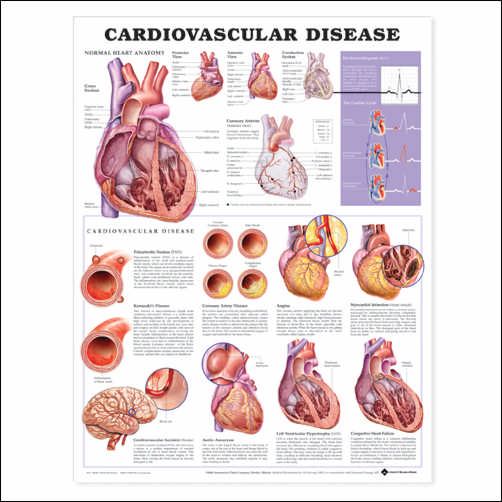The heart
The human heart is the size of a fist. However, it works relentlessly from before birth to death. The heart begins beating by 21 to 28 days after conception and beats throughout life. It is also the strongest muscle in the human body.
The average heart beats about 100,000 times daily or about two and a half billion times over a seventy year lifetime. With each beat the heart pumps blood through the blood vessels or arteries to all parts of the body. It beats approximately 70 to 80 times a minute. This rate can double during exercise or at times of emotion.
The cardiovascular system
The blood from the heart travels from the left side of the heart and is rich in oxygen. It travels via arteries of ever-decreasing size till it reaches the narrowest of arteries called capillaries in all the organs and parts of the body.
Having delivered its oxygen and nutrients and having collected waste products, blood is brought back to the right side of the heart through a system of progressively enlarging veins. This is called the circulatory system or the cardiovascular system and is vital for living. Cardiovascular system literally means “cardio” or heart and “vascular” or a system or network of blood vessels.
How many people do cardiovascular diseases affect?
Diseases of disorders of this system are termed cardiovascular diseases. Cardiovascular diseases kill an estimated 17 million people worldwide each year. Majority of these are due to heart attacks and strokes.
Tobacco consumption and smoking remains the largest risk factor for cardiovascular diseases worldwide. It raises the risk of strokes as well.
Physical inactivity and unhealthy diet leading to obesity are other important risk factors which increase individual risks to cardiovascular diseases.
Types of cardiovascular disease
Some of the cardiovascular diseases include:
Coronary heart disease
This is due to disease or narrowing of the blood vessels supplying the heart muscle. These blood vessels are called coronary blood vessels. Atherosclerosis is the most common cause and is caused due to hardening and narrowing of coronary arteries of heart by formation of plaques and plugs.
Coronary heart disease can be caused due to risk factors like high blood pressure, high blood cholesterol, tobacco use, obesity, unhealthy diet, physical inactivity, diabetes, advancing age, inherited disposition.
Congenital heart disease
This is due to malformation or abnormal formations of the structures of the heart at birth. This may be inherited or due to other factors. This includes holes in the heart, abnormal valves, abnormal heart chambers etc. Mothers taking drugs, alcohol, mothers with infections like rubella or mothers with poor diets deficient of vital nutrients are at risk of giving birth to babies with congenital heart defects.
Stroke or Cerebrovascular accident (CVA)
This is caused when the blood supply to part of the brain is hampered. This may result from either blockage or rupture of a blood vessel in the brain. Those at risk include those with high blood pressure, heart rhythm disorders, high blood cholesterol, tobacco use, diabetes and advancing age.
Congestive heart failure
This is caused when the heart muscles become progressively unable to pump blood into the blood vessels. Those at risk include those with high blood pressure, heart rhythm disorders, heart attacks, obesity etc.
Peripheral arterial disease or peripheral vascular diseases
This affects the arteries supplying the arms and legs. The risks are similar as those for coronary heart disease.
Deep venous thrombosis (DVT) and pulmonary embolism
In DVT, blood clots form in the leg veins giving rise to severe pain and disability. These clots can dislodge and move to the heart and lungs leading to life threatening complications. Risk factors include long surgery, trauma, obesity, cancers, recent childbirth, use of oral contraceptive and hormone replacement therapy etc.
Rheumatic heart disease
This is caused due to damage to the heart muscle and heart valves from rheumatic fever. This is caused due to infection with streptococcal bacteria.
Other cardiovascular diseases
This includes tumours of the heart, blood vessel tumors or ballooning (aneurysm) of the blood vessels of the brain, cardiomyopathy, heart valve diseases, disorders of the lining of the heart or pericarditis, aortic aneurysm etc.


This is a vein and vascular center that has multiple locations. They are located in near PHOENIX, ARIZONA, USA. Office locations are, Surprise, Arizona, USA, - Goodyear, Arizona USA, Chandler, Arizona USA and Gilbert , Arizona USA. These cities surround Phoenix, so we want to focus on each city and about a 20 mile radius around each one as well as Phoenix itself since it is in the center of all these cities.
ReplyDelete